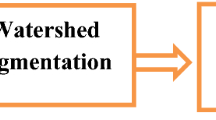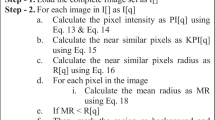Abstract
Today, image segmentation plays a vital role in many crucial areas. This paper will cover the important role that image segmentation plays in medical imaging issues. Image segmentation is the process of dividing a random image into groups or partitions; the main goal here is to separate the objects from the background, to make it easier to analyze each of them individually, like in our case when the purpose is to detect and segment the tumor. In the upcoming sections, we’ll be presenting a new medical imaging technique for detecting brain tumors in MRI images. For this, we will use two algorithms. The first one is Birch which is a fast hierarchical method of grouping and reducing data. The second algorithm is the segmentation by the Watershed, these two algorithms will be explained further in detail. The first step is to segment the input MRI image using the Birch method, then the resulting image will be launched into the second algorithm which is the Watershed. The proposed method has been applied and tested on 155 images from the Kaggle dataset to detect abnormalities such as tumors. According to the results, we can say that it gives a satisfactory and efficient detection result. To evaluate the performance of our proposed method, we used a very known set of parameters such as the dice coefficient that reached 96%, the sensitivity achieved 99%, in specificity we obtained 98, and a Jaccard similarity of 94%. All the given evaluating metrics achieved satisfactory results and good segmentation of the brain tumor. Furthermore, our proposed approach was compared to the SOTA methods, and the obtained results outperformed the state-of-the-art brain tumor extraction by 5%.




Similar content being viewed by others
Data availability
The data that support the findings of this study are openly available in [yes] at [https://www.kaggle.com/datasets/navoneel/brain-mri-images-for-brain-tumor-detection], reference number [kaggle datasets download -d navoneel/brain-mri-images-for-brain-tumor-detection].
References
Hesamian MH, Jia W, He X, et al. Deep learning techniques for medical image segmentation: achievements and challenges. J Digit Imaging. 2019;32:582–96. https://doi.org/10.1007/s10278-019-00227-x.
Moussaoui H, Benslimane M, et El Akkad N. Image segmentation approach based on hybridization between K-means and mask R-CNN. In: WITS 2020. Springer, Singapore, 2022. p. 821–30.
Khrissi L, El Akkad N, Satori H et al. An efficient image clustering technique based on fuzzy c-means and cuckoo search algorithm. Int J Adv Comput Sci Appl. 2021;12(6).
Jaglan P, Dass R, et Duhan M. A comparative analysis of various image segmentation techniques. In: Proceedings of 2nd International Conference on Communication, Computing and Networking. Springer, Singapore, 2019. p. 359–74.
Khrissi L, El Akkad N, Satori H et al. A performant clustering approach based on an improved sine cosine algorithm. 2022.
El Akkad N, El Hazzat S, Saaidi A, Satori K. Reconstruction of 3D scenes by camera self-calibration and using genetic algorithms. 3D Res. 2016;6(7):1–17. https://doi.org/10.1007/s13319-016-0082-y.
Moussaoui H, El Akkad N, et Benslimane M. Moroccan carpets classification based on SVM classifier and ORB features. In: International conference on digital technologies and applications. Springer, Cham, 2022. p 446–55.
El Akkad N, Merras M, Baataoui A, Saaidi A, Satori K. Camera Self-calibration having the varying parameters and based on homography of the plane at infinity. Multimed Tools Appl (Springer). 2017;77(11):14055–75.
El Akkad N, Merras M, Saaidi A, Satori K. Camera self-calibration with varying intrinsic parameters by an unknown three-dimensional scene. Visual Comput (Springer). 2014;30(5):519–30.
Akkad NE, Merras M, Saaidi A, Satori K. Robust method for self-calibration of cameras having the varying intrinsic parameters. J Theor Appl Inf Technol. 2013;50(1):57–67.
Akkad NE, Merras M, Saaidi A, Satori K. Camera self-calibration with varying parameters from two views. WSEAS Trans Inf Sci Appl. 2013;10(11):356–67.
El Akkad N, Saaidi A, Satori K. Self-calibration based on a circle of the cameras having the varying intrinsic parameters. In: Proceedings of 2012 International Conference on Multimedia Computing and Systems, ICMCS, 2012. p. 161–6.
Khrissi L, El Akkad N, Satori H, Satori K. Simple and efficient clustering approach based on cuckoo search algorithm. In: 2020 Fourth International Conference On Intelligent Computing in Data Sciences (ICDS), 2020. 1–6. https://doi.org/10.1109/ICDS50568.2020.9268754.
Khrissi L, El Akkad N, Satori H, Satori K. Image segmentation based on K-means and genetic algorithms, 2020.https://doi.org/10.1007/978-981-15-0947-6_46.
Khrissi L, Akkad NE, Satori H, Satori K. Color image segmentation based on hybridization between Canny and k-means. In: 7th Mediterranean Congress of Telecommunications 2019, CMT 2019, 2019. https://doi.org/10.1109/CMT.2019.8931358.
Khrissi L, El Akkad N, Satori H, Satori K. Clustering method and sine cosine algorithm for image segmentation. Evol Intel. 2021. https://doi.org/10.1007/s12065-020-00544-z.
Wang Z, Wang E, et Zhu Y. Image segmentation evaluation: a survey of methods. Artif Intell Rev. 2020;53(8):5637–74.
Sreerangappa M, Suresh M, Jayadevappa D. Segmentation of brain tumor and performance evaluation using spatial FCM and level set evolution. Open Biomed Eng J. 2017;13(Suppl-1): M6. https://doi.org/10.2174/1874120701913010134.
Bahadure NB, Ray AK, Thethi HP. Image analysis for MRI based brain tumor detection and feature extraction using biologically inspired BWT and SVM. Int J Biomed Imaging. 2017. https://doi.org/10.1155/2017/9749108. (Article ID 9749108).
Kumar BV. Brain tumour Mr image segmentation and classification using by PCA and RBF Kernel based support vector machine. Middle-East J Sci Res. 2015;23(9):2106–16. https://doi.org/10.5829/idosi.mejsr.2015.23.09.22458.
Alam MS, Rahman MM, Hossain MA, Islam MK, Ahmed KM, Ahmed KT, Singh BC, Miah MS. Automatic human brain tumor detection in MRI image using template-based K means and improved fuzzy C means clustering algorithm. Big Data Cogn Comput. 2019;3:27. https://doi.org/10.3390/bdcc3020027.
Zotin A, Simonov K, Kurako M, Hamad Y, Kirillova S. Edge detection in MRI brain tumor images based on fuzzy C-means clustering. Procedia Computer Science. 2018;126:1261–70. https://doi.org/10.1016/j.procs.2018.08.069.
Sandhya G, Kande GB, Savithri S. A novel approach for the detection of tumor in MR images of the brain and its classification via independent component analysis and kernel support vector machine. Res Article - Imaging Med. 2017;9(3). (ISSN: 1755–5191)
Richard B, Jian C, Christopher A, Timothy S, Deanne T, Joseph Y, Vicki A, Marc S, Amanda W. Brain extraction using the watershed transform from markers. Front Neuroinf J. 2013. https://doi.org/10.3389/fninf.2013.00032.
Pandav S. Brain tumor extraction using marker controlled watershed segmentation. Int J Eng Res Technol (IJERT). 2014;3(6). (ISSN: 2278–0181)
Dong H, Yang G, Liu F et al. Automatic brain tumor detection and segmentation using U-Net based fully convolutional networks. In: Annual conference on medical image understanding and analysis. Springer, Cham, 2017. p. 506–17.
Kornilov AS, et Safonov IV. An overview of watershed algorithm implementations in open source libraries. J Imaging. 2018;4(10):123.
Ramesh KKD, Kumar GK, Swapna K, et al. A review of medical image segmentation algorithms. EAI Endorsed Trans Pervasive Health Technol. 2021;7(27): e6.
Lu Y, Jiang Z, Zhou T, Fu S. An improved watershed segmentation algorithm of medical tumor image. IOP Conference Series: Materials Science and Engineering, Volume 677, Issue 4
Thanki RM, Kothari AM (2019) Morphological image processing. In: Digital image processing using SCILAB. Springer, Cham. https://doi.org/10.1007/978-3-319-89533-8_5.
Zhou H, Song K, Zhang X, Gui W, Qian Q. WAILS: watershed algorithm with image-level supervision for weakly supervised semantic segmentation. IEEE Access. 2019;7:42745–56. https://doi.org/10.1109/ACCESS.2019.2908216.
Romen Singh T, Roy S, Imocha Singh O, Sinam T, Manglem Singh KH. A New Local Adaptive Thresholding Technique in Binarization. IJCSI Int J Comput Sci Issues, Vol. 8, Issue 6, No 2, November 2011 ISSN: 1694–0814 www.IJCSI.org.
Kumar N, et Nachamai M. Noise removal and filtering techniques used in medical images. Orient J Comput Sci Technol. 2017;10(1):103–13.
Yin S, Li H, Liu D, et al. Active contour modal based on density-oriented BIRCH clustering method for medical image segmentation. Multimed Tools Appl. 2020;79(41):31049–68.
Wang X, Wang X, et Wilkes DM. An efficient image segmentation algorithm for object recognition using spectral clustering. In: Machine learning-based natural scene recognition for mobile robot localization in an unknown environment. Springer, Singapore, 2020. p. 215–34.
Lorbeer B, Kosareva A, Deva B, Softić D, Ruppel P, Küpper A. Variations on the clustering algorithm BIRCH. Big Data Res. 2018;11:44–53. https://doi.org/10.1016/j.bdr.2017.09.002. (ISSN 2214-5796).
Shehab LH, Fahmy OM, Gasser SM, et al. An efficient brain tumor image segmentation based on deep residual networks (ResNets). J King Saud Univ-Eng Sci. 2021;33(6):404–12.
Ranjbarzadeh R, Bagherian Kasgari A, Jafarzadeh Ghoushchi S, et al. Brain tumor segmentation based on deep learning and an attention mechanism using MRI multi-modalities brain images. Sci Reports. 2021;11(1):1–17.
Wang G, Li W, Ourselin S, et al. Automatic brain tumor segmentation based on cascaded convolutional neural networks with uncertainty estimation. Front Comput Neurosci. 2019;13:56.
Wang Y, Zhang Y, Hou F et al. Modality-pairing learning for brain tumor segmentation. In: International MICCAI Brainlesion Workshop. Springer, Cham, 2021. p. 230–40.
Jia H, Cai W, Huang H et al. H2NF-Net for brain tumor segmentation using multimodal MR imaging: 2nd place solution to BraTS challenge 2020 segmentation task. In: Brainlesion: Glioma, Multiple Sclerosis, Stroke and Traumatic Brain Injuries-6th International Workshop, Springer. 2021. p. 58–68
Isensee F, Jäger PF, Full PM et al. nnU-Net for brain tumor segmentation. In: International MICCAI Brainlesion Workshop. Springer, Cham, 2021. p. 118–32.
Jun MA. Cutting-edge 3D medical image segmentation methods in 2020: Are happy families all alike?. arXiv preprint, 2021. arXiv:2101.00232.
Author information
Authors and Affiliations
Corresponding author
Ethics declarations
Conflict of Interest
On behalf of all authors, the corresponding author states that there is no conflict of interest.
Additional information
Publisher's Note
Springer Nature remains neutral with regard to jurisdictional claims in published maps and institutional affiliations.
Rights and permissions
Springer Nature or its licensor (e.g. a society or other partner) holds exclusive rights to this article under a publishing agreement with the author(s) or other rightsholder(s); author self-archiving of the accepted manuscript version of this article is solely governed by the terms of such publishing agreement and applicable law.
About this article
Cite this article
Moussaoui, H., El Akkad, N. & Benslimane, M. A Brain Tumor Segmentation and Detection Technique Based on Birch and Marker Watershed. SN COMPUT. SCI. 4, 339 (2023). https://doi.org/10.1007/s42979-023-01802-4
Received:
Accepted:
Published:
DOI: https://doi.org/10.1007/s42979-023-01802-4




